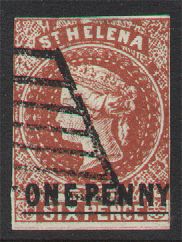


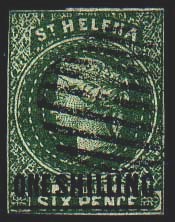
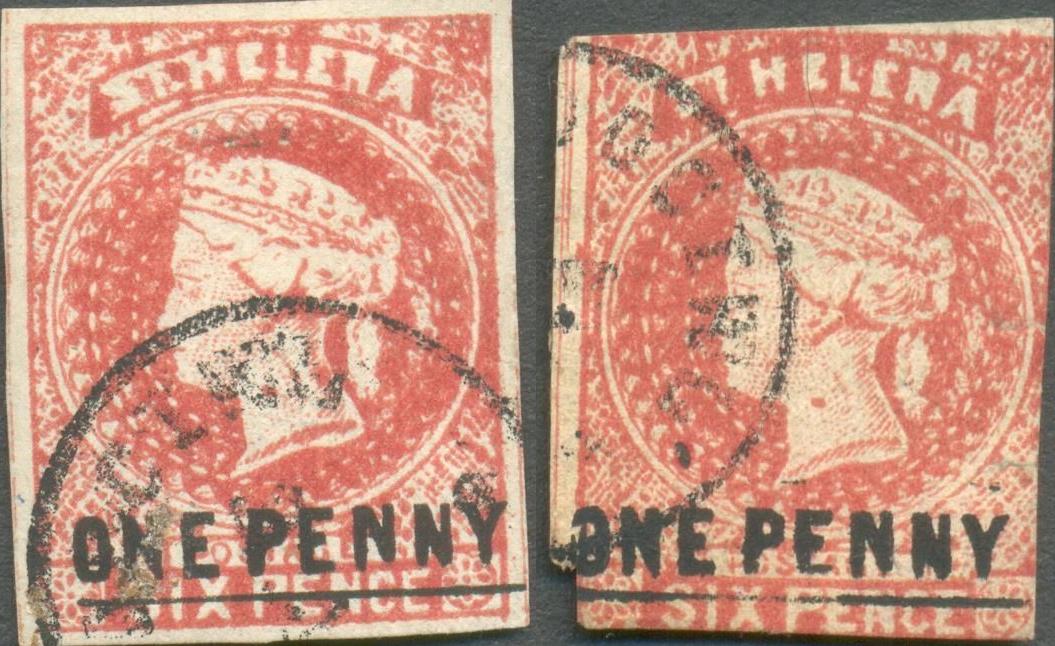

Return To Catalogue - St Helena 1856-1899 - St Helena 1890-1920
Note: on my website many of the
pictures can not be seen! They are of course present in the cd's;
contact me if you want to purchase them: evert@klaseboer.com.
There exists a booklet made by Roger West, describing 16 different kinds of forgeries. He made another forgery 'The Seventeenth Facsimile', he told me that he produced it around 1990: "While i was studying the St Helena types, I felt the best way to become familiar with the various problems was to do one myself. I have to say that I obtained permission from the Crown Agents and set my own restrictions. They were designed as a copy of a forgery rather than a copy of the original, as all I wanted was a recognisable design within a rectangle. They were also produced on the understanding that I did not sell them." I would like to thank Roger for sending me this little booklet, together with some of these 17th facsimiles. This booklet is highly recommendable for the collectors of St. Helena who are interested in forgeries.
The 'S' of 'SIX' is placed too far too the right in this forgery. In the genuine stamps, the background pattern should make a 'W' shape above the left and right hand side of the 'St. HELENA' label. This is absent in this forgery. Note the different hair hanging down from the back of the head of the Queen. The rings with dots around the head are more clearly visible in this forgery than in the genuine stamps. The surcharged horizontal line at the bottom of these stamps is very thin. Also note the very strange cancel, a diamond with lines, concentric rings with some horizontal lines in the center, an ellipse filled up with horizontal lines or a pattern of dots (not shown).
The background pattern in the above forgeries is quite different from the genuine stamps. The 'S' of 'SIX' is badly shaped. The 'H' pf 'HELENA' has a very thin horizontal stroke and the first 'E' of this word has the central stroke placed too high up. This forgery made by the Spiro Brothers in Hamburg, Germany. Note the very strange cancels, which have never been used in St.Helena. This forgery is also mentioned in the Spud Papers LX. Spiro forgeries are the most common forgeries of St.Helena.


(Doubly cancelled Spiro forgeries?)
I have seen the same cancel 'BO*TDK' (as the on the 5 Sh forgery) on a Spiro forgery of Western Australia.

(forgery, reduced size)
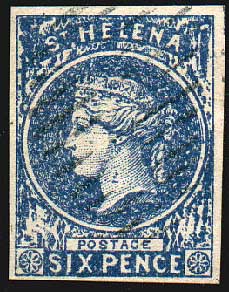
(Image obtained thanks to Bill Claghorn's forgery site: http://www.geocities.com/claghorn1p/
)
According to the above mentioned booklet of Roger West, this forgery was made by David Cohn. It resembles much the Spiro forgeries. Only the value 6 p blue was issued. I've seen a full sheet of 60 of these forgeries (5 columns of 12 stamps). Apparently, the cancel is rather typical for this forgery (parallel lines).
(Sorry, no picture available now)
This is the fifth forgery described in Album Weeds. A white line is surrounding the label with "St.HELENA" in this forgery. There is a stop behind "POSTAGE". I have no picture of this forgery right now.
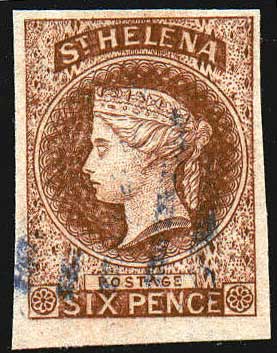
(This forgery was obtained from the forgery site of Bill
Claghorn)
This is the sixth forgery described in Album Weeds. There is a large stop below the 'T' of 'ST HELENA'. This forgery is engraved as the genuine stamps. Note, that there is a white line at the base of the neck. The eye is very white. This forgery was made by Oneglia.
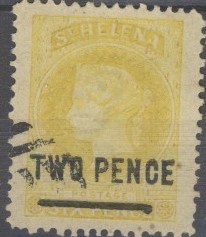
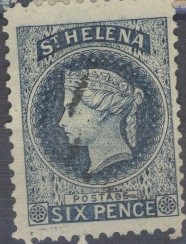
Possibly also Oneglia forgeries of the 2 p and 6 p values with a
very wide border.
In the above forgeries, the 'L' of 'HELENA' is slanting backwards. The letters in 'St.HELENA' are much thinner than in the genuine stamp. The surcharge is different from the genuine one (especially the large '2'). I have seen many forgeries with the cancel 'ST HELENA SR 24 01', on this forgery and on the next forgery (note that 'SR' should have been 'SP'). It was made by De Benckelaer according to the booklet of Roger West. Other sources say that this forgery was made by the Belgian biscuit and chocolate factory De Beukelaer as free gifts with their biscuits.

Forgery with cancel 'ST HELENA SR 24 01'
The background pattern is very different from the genuine stamp. The surcharge is different from the genuine one (especially the large '2'). Note that there are two very distinct 'M's besides the label with the word 'POSTAGE'. This forgery also bears the cancel 'ST HELENA SR 24 01'. It was made by De Benckelaer (as was the sixth forgery).
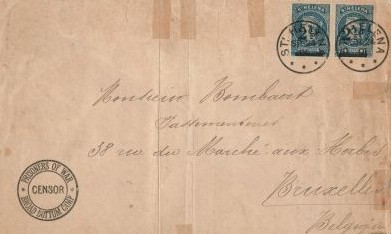
Two of these or the previous forgery on a letter adressed to
'Monsieur Bombaert' in Brussels, with a forged 'PRISONERS OF WAR
CENSOR BROAD BOTTOM CAMP' cancel.
The 'PRISONERS OF WAR' cancel doesn't resemble the genuine cancels I have seen sofar:
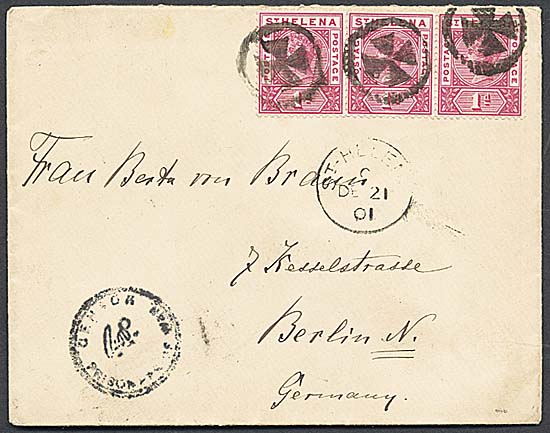
Cross in circle cancel on three 1 p stamps on a genuine prisoner
of war envelope

Bar cancels on a genuine prisoner of war envelope with violet
'PRISONERS OF WAR BROAD BOTTOM CAMP CENSOR' cancel
These forgeries were made by Panelli. They can be distinguished by two white dots behind the chignon (information obtained from the booklet of Roger West). Two different Panelli forgeries exist, engraved and lithographed (same distinghuishing characteristics).
Very primitive forgeries:

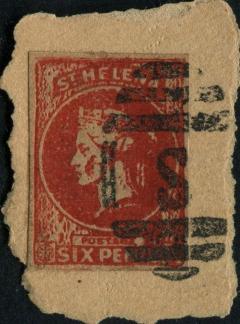
Note the red smudge on the face of the Queen. The second forgery
is pasted on a piece of paper and obliterated with a 'S' cancel.
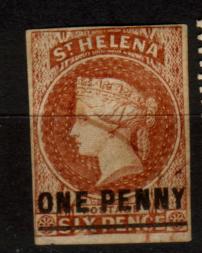
(Forgery)
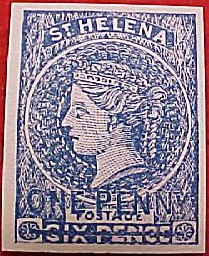
A very primitive forgery of the 1 p on 6 p blue; even the
surcharge 'ONE PENNY' is printed in blue.

A rather primitive forgery on bluish paper

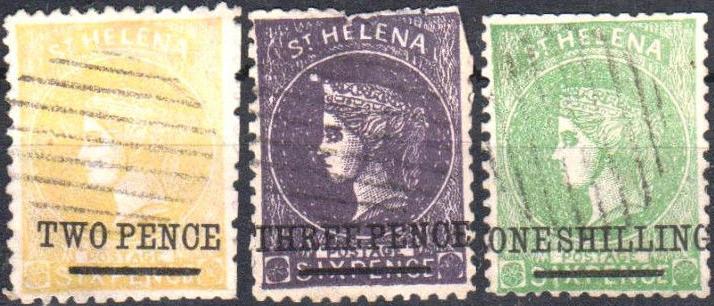
Primitive forgeries with very pronounced shading on the cheek of
the Queen. Note the weird shape of the 'S' of 'ST'.
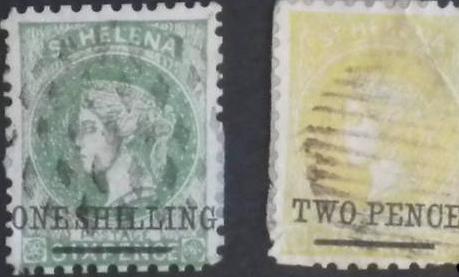
These forgeries have overprints with 'serifs'.
A very dangerous forgery is described in Album Weeds as forgery 1; the label with 'St. HELENA' is cut off straight at the left and right. In the genuine stamps, the engine turning background should enter this label. These forgeries are perforated 12 or imperforate.
Example of a forgery with double surcharge and a genuine double overprinted stamp for comparison:
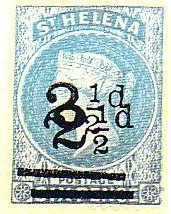
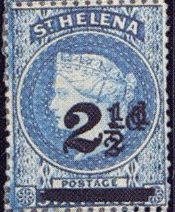
(Left image forgery, obtained thanks to Robert W. Richardson;
right image genuine double overprint, image obtained with
permission from http://www.sandafayre.com
)

Fournier forgery, with 'FAUX' overprint.
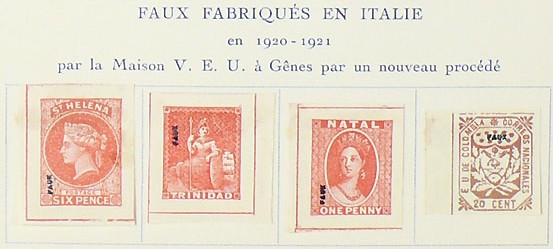
Part of the page from the Fournier Album
In 'The Fournier Album of Philatelic Forgeries' a 6 p forgery can be found (imperforate) sold by Fournier. Apparently this forgery was not made by him, the text reads: 'Faux fabriques en Italie en 1920-1921 par la Maison V.E.U. à Gênes par un nouveau procédé' (forgeries made in Italy in 1920-21 by the house of V.E.U. in Genova with a new technique. So these forgeries were produced after Fournier had died. This forgery only seems to exist with the overprint 'FAUX', it is also in red instead of blue.
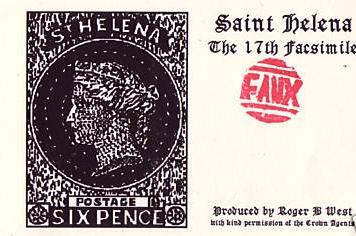
Here an example of a Roger West forgery. He also made enlarged
images on postcard sized paper (as shown above). I've only seen
this forgery in the color black.
This forgery is not that deceptive and was created by Roger West:, he mentions: "While i was studying the St Helena types, I felt the best way to become familiar with the various problems was to do one myself. I have to say that I obtained permission from the Crown Agents and set my own restrictions. They were designed as a copy of a forgery rather than a copy of the original, as all I wanted was a recognisable design within a rectangle. They were also produced on the understanding that I did not sell them."
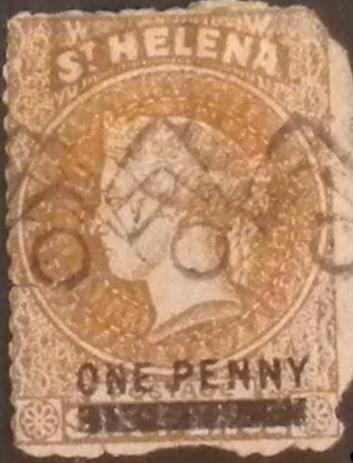
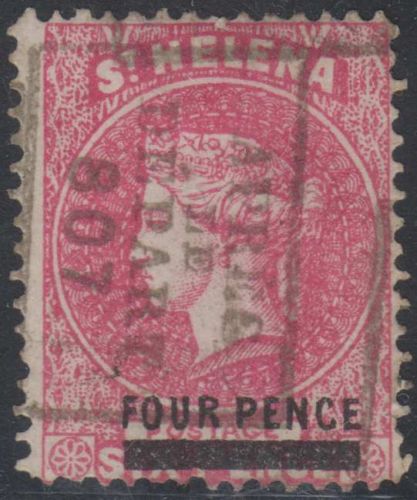



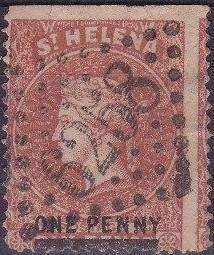
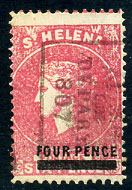
Yet another primitive forgery. Note the cancels "APRES LE
DEPART 807", "1546" and "6258" numeral
cancels and the "AIGREFEUILLE" cancel. They appear to
be of French origins.
Stamps - Timbres-Poste - Briefmarken